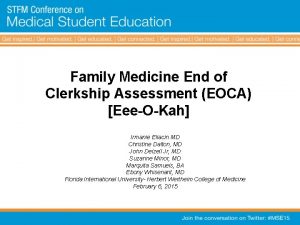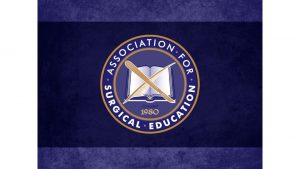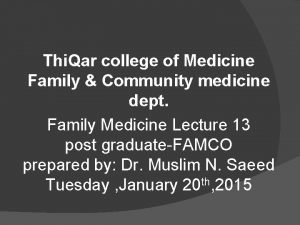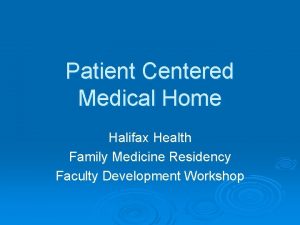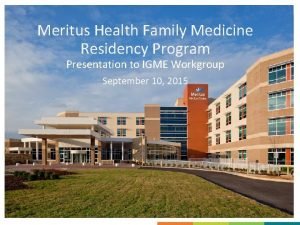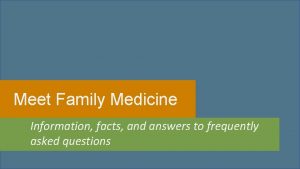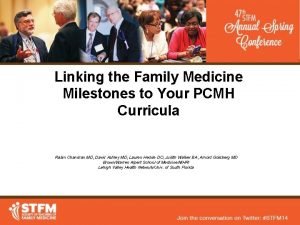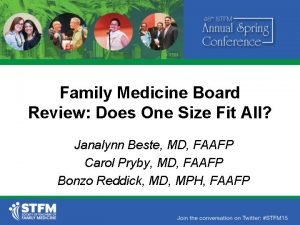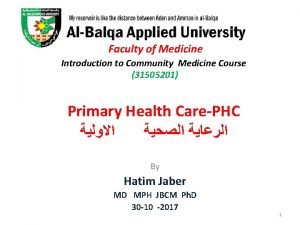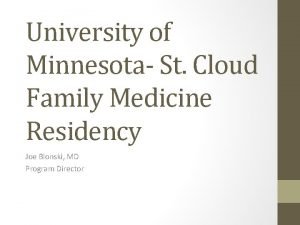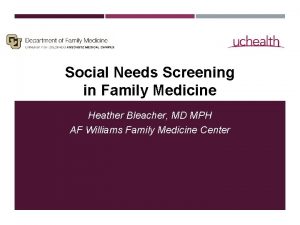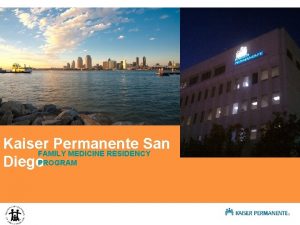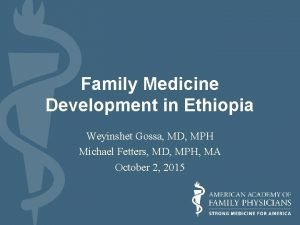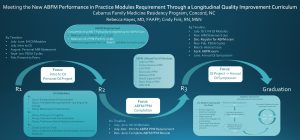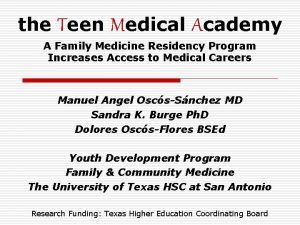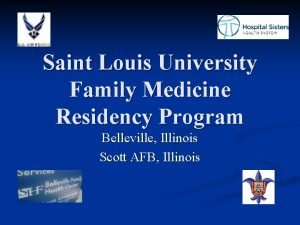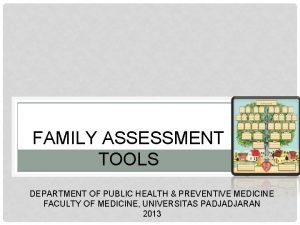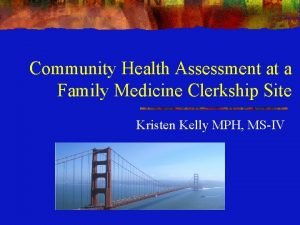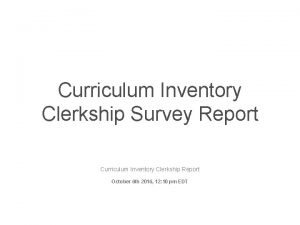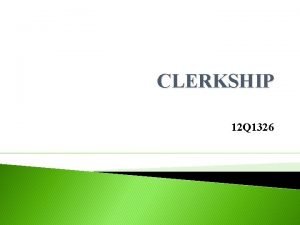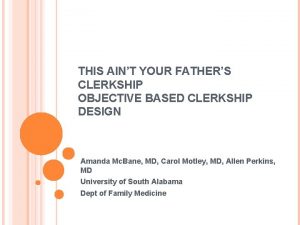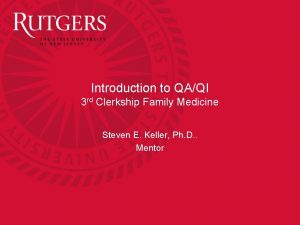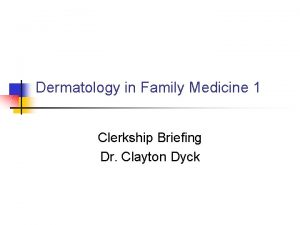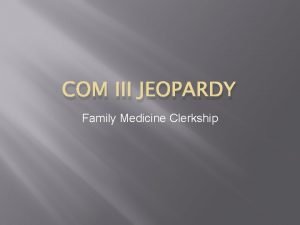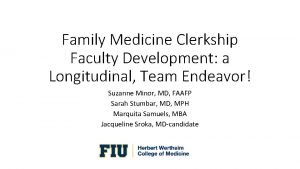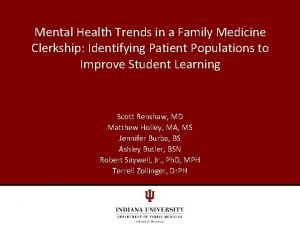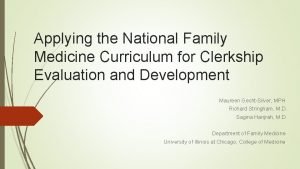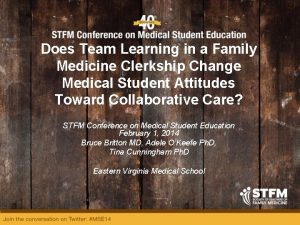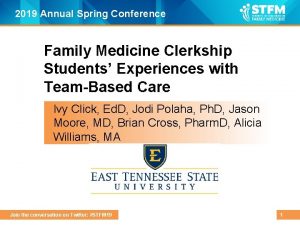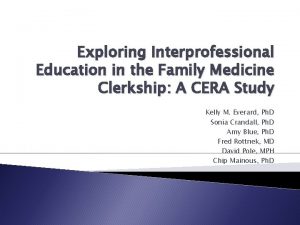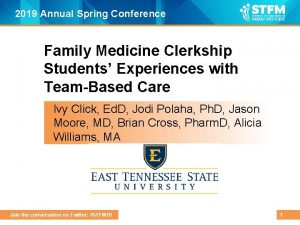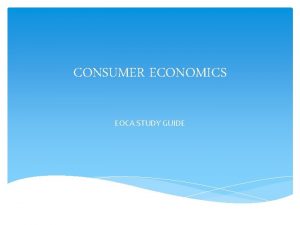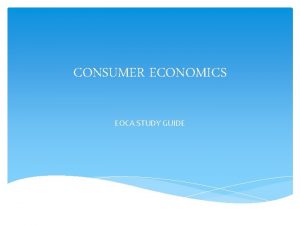Family Medicine End of Clerkship Assessment EOCA EeeOKah
![Family Medicine End of Clerkship Assessment (EOCA) [Eee-O-Kah] Irmanie Eliacin MD Christine Dalton, MD Family Medicine End of Clerkship Assessment (EOCA) [Eee-O-Kah] Irmanie Eliacin MD Christine Dalton, MD](https://slidetodoc.com/presentation_image_h2/aa26fb8e4aed2220210506b1aa651f87/image-1.jpg)



















- Slides: 20
![Family Medicine End of Clerkship Assessment EOCA EeeOKah Irmanie Eliacin MD Christine Dalton MD Family Medicine End of Clerkship Assessment (EOCA) [Eee-O-Kah] Irmanie Eliacin MD Christine Dalton, MD](https://slidetodoc.com/presentation_image_h2/aa26fb8e4aed2220210506b1aa651f87/image-1.jpg)
Family Medicine End of Clerkship Assessment (EOCA) [Eee-O-Kah] Irmanie Eliacin MD Christine Dalton, MD John Delzell Jr, MD Suzanne Minor, MD Marquita Samuels, BA Ebony Whisenant, MD Florida International University- Herbert Wertheim College of Medicine February 6, 2015

Disclosures • No Disclosures

Objectives • Gain knowledge on the aspects of the End of Clerkship Assessment (EOCA) including details of stations and their objectives. • Explain the different processes in developing an EOCA and implementing it into all clerkship rotations. • Correlate their students EOCA with the NBME shelf exam and other parameters.

Introductions • Irmanie Eliacin MD Assistant Clerkship Director • Christine Dalton, MD Instructor • John Delzell Jr, MD Director of Student Education • Suzanne Minor, MD Clerkship Director • Marquita Samuels, BA Clerkship Coordinator • Ebony Whisenant, MD Assistant Clerkship Director

Background • Why did we decide to develop an OSCE? – Another tool to evaluate clinical knowledge – Expanded to use more outside clinical preceptors • Ensure students were gaining an equitable learning experience consolidating core topics assessed in family medicine.

Questions we want to answer… • Does our EOCA give additional info about students (different than NBME or ASPC)? • Does a new EOCA / OSCE have reasonable validity? • Does our EOCA give additional info about students at academic sites vs community preceptor sites ?

Curriculum Design…What went into choosing the stations? • Students struggled with formulating complete problem list, thorough assessment, plan and differential diagnosis. – A Standardized Patient (SP) station • targeted several key chronic medical conditions • evaluating students ability to develop comprehensive recommendation and plans. – Post Encounter Note – Oral presentation to faculty

Curriculum Design…What went into choosing the stations? • Students had trouble with pharmacology and writing prescriptions. – Sections required mock prescription, orders, studies and recommended treatment for different acute and chronic conditions

Curriculum Design… How were the assessment tools created? • Rubrics developed for each station based on topic and assessment – Point system – Check list, etc • Research and cross reference • Time commitment

Curriculum Design EOCA Station Assessments Time 1 DM/HTN SP Station Post Encounter Note Oral Presentation EKG Station Dermatology Station Paper Cases with Knowledge Assessments q Preventative Medicine (Case A) q Pedigree ~ Hyperlipidemia (Case B) q Asthma (Case C) q UTI/Vaginitis (Case D) q HTN/DM/Hypothyroid (Case E) 15 minutes 2 3 4 5 6 15 minutes 90 minutes

Evaluation of Student Performance • Four rotations completed so far – Total of 73 students (41 more students to complete)

Evaluation of Student Performance Average Overall EOCA Overall NBME Overall ASPC (Clinical Assessment ) 86. 68 82. 77 89. 74

Evaluation of Student Performance Overall Performance 96 94 92 90 88 86 84 82 80 78 76 Group 1 Group 2 Group 3 EOCA NBME Group 4 ASPC

92 Evaluation of Student Performance : Academic Centers vs Community Preceptor ~ EOCA 90 88 86 Comm EOCA 84 Academic EOCA 82 80 78 Group 1 Group 2 Group 3 Group 4

Evaluation of Student Performance : Academic Centers vs Community Preceptor ~ NBME 85 84 83 Comm NBME 82 Academic NBME 81 80 79 Group 1 Group 2 Group 3 Group 4

Challenges • • • Time Deadlines Coordinating Accuracy/Cross Reference Technical Challenges Bias – One faculty grading all assessments/rubrics

Conclusions & Lessons Learned • Its really easy to start a new OSCE … No it’s really not! • Students complain about the amount of time for each station. . . – It’s ok

Questions? ? ?


Please evaluate this session at: stfm. org/sessionevaluation
 Sp eoca
Sp eoca Lcme clerkship requirements
Lcme clerkship requirements Types of family in community medicine
Types of family in community medicine Principles of family medicine
Principles of family medicine Halifax family medicine residency
Halifax family medicine residency Meritus primary care
Meritus primary care Family medicine procedures
Family medicine procedures Milestones family medicine
Milestones family medicine Family medicine boards review
Family medicine boards review Principles of primary health care
Principles of primary health care Family medicine definition
Family medicine definition Internal medicine shelf percentiles
Internal medicine shelf percentiles Function of the family
Function of the family St cloud family medicine residency
St cloud family medicine residency Af williams clinic
Af williams clinic Kaiser permanente san diego family medicine residency
Kaiser permanente san diego family medicine residency Family medicine in ethiopia
Family medicine in ethiopia Cabarrus family medicine concord
Cabarrus family medicine concord Uthscsa internal medicine residents
Uthscsa internal medicine residents St louis family medicine residency
St louis family medicine residency Screem family tool
Screem family tool
